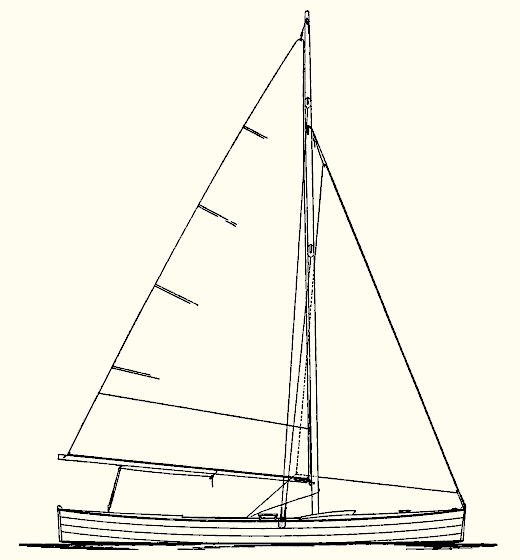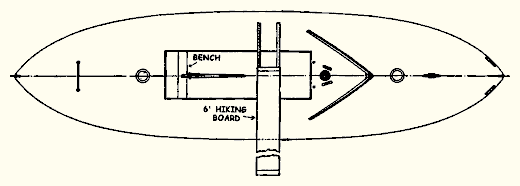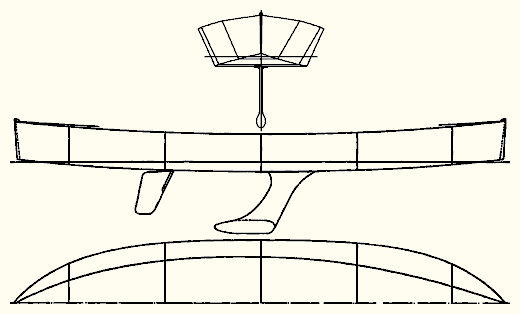
| Flying Saucer A 17' 10" Flat-Bottom Fin-Keel Knockabout By William Atkin |
| A Planing Sailing Boat | |
| During the late twenties the Huntington Yacht Club sponsored the Development Class of fast centerboard sailing boats. This class was popularly known as the Suicide Class, not because the boats were dangerous to sail, but because the insignia indicating the class was the old piratical device, a skull and cross-bones. Many of these boats were astonishingly fast. The boats were in the neighborhood of 18 feet over all and from 4 to 6 feet in breadth and all were of centerboard type. The principal restrictions of the Development Class are: no keels, not less than 3 feet 6 inches beam, nor more than 125 square feet sail area, a limitation of 50 pounds weight for a centerboard and a crew of two. Reaching in a strong breeze, despite the modest sail area, these boats really travelled very fast and in strong puffs, if you could keep them right side up without reefing, showed all the characteristics of planing. With more sail,a ballasted keel and a long hiking board to gain stability I have no doubt that speeds up to 12 miles an hour would be easily possible with hulls similar to those of the Development Class boats. And with this thought in view I present here designs of Flying Saucer, a planing sailing boat. | |

| |
| The rig is simple and practical for this or any other kind of small boat. Notice both shrouds lead to a common chain plate. I presume the experts will soon complicate the rigging on Flying Saucer. In connection with this it may not be amiss to quote the comment of the editor of Yachting World for December 1948, an authoritative British boating magazine, as it concerns the efficient and simple rig and sail plan of Uffa Fox's latest planing sailing boat, The Flying Twenty Five. "The return to a simple rigging plan is very welcome for the complicated arrangements now in use are undoubtedly a source of trouble and expense. The implication that the rig is stronger because it is simple should probably be qualified by the fact that it is heavier and unless restrictions are imposed before long we are likely to find Flying Twenty Fives with the same cobwed of shrouds and stays that has grown up on the other small classes." It greatly pleases me to know I am not alone in believing in the value of simplicity afloat. The sail area of Flying Saucer is 152 square feet. | |

| |
| The deck has expanse, leaving only a narrow opening for the cockpit which, by the way, is 21 inches wide by 5 feet 3 inches long. The little boat can heel down a long way before shipping water, in fact she might be knocked down on her beam ends and if luffed up shake herself free. In connection with this there is in each end of the hull a large flotation compartment with ample capacity to float the boat if the cockpit is filled with water. All sailing boats of small size should be so fitted. The hiking board is 6 feet long and when fully extended stands out beyond the rail a matter of 4 feet 4 inches. The hiking board runs on tracks fitted to the deck and crossing the forward end of the cockpit as shown leaving room each side for leg room in the cockpit. An unusual sensation will come to the man on the end of the hiking board because he will be able to see the boat he is sailing on from bow to stern rushing over the water, and also watch the fin and rudder slicing along if the water is clear. After an exhilarating sail on a boat like Flying Saucer racing one of the ubiquitous one-design sailing boats so much in vogue will seem tame indeed. | |

| |
| With a view to simplicity, and because the form is excellent for planing purposes at speeds up to 12 miles an hour or so, I have centered on a flat bottom hull of double-end model. Flying Saucer, is then, 17 feet 10 inches in over all length; 16 feet on the water line; 4 feet 8 inches in breadth; and 4 inches draft (hull only). The draft to the bottom of the fin keel is 2 feet 7 3/4 inches. The freeboard at the bow and stern is 1 foot 6 inches and the freeboard amidships, slightly over 1 foot. The deck line, sheer line, and sweep of the bottom are alike both ends; but the breadth of the bottom abaft station 6 is greater than it is in the forward stations, for several reasons. The fin and rudder will weigh approximately 210 pounds, the center of weight of these two appendages being about 22 inches below the L.W.L. With these low weights combined with the movable weight of the helmsman on deck and the crew on the end of the hiking board, the little boat will be able to carry a grand press of sail. | |
| Plans for Flying Saucer are $100 MYSTIC SEAPORT MUSEUM SHIPS PLANS STORE https://store.mysticseaport.org/ships-plans/ shipsplanstore@mysticseaport.org
+1 (860) 572 5360 | |
| BACK TO PLAN LIST | |